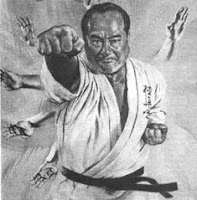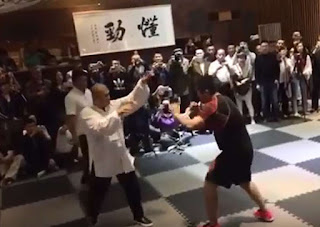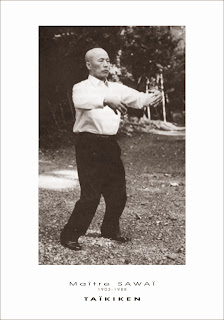Keeping grapplers at bay
 Brazilian jujutsu practitioners are fond of saying that most fights go to the ground, but as Chad Merriman (also a strong Judo player) likes to say, that's because most people don't know how to stop them from going to the ground.
Brazilian jujutsu practitioners are fond of saying that most fights go to the ground, but as Chad Merriman (also a strong Judo player) likes to say, that's because most people don't know how to stop them from going to the ground.It is important to note that I think one should learn grappling skills regardless of one’s “stand-up” fighting ability. But there have been times where I have not wanted to go to ground for the simple reason that I know my opponent is better there. I have managed to stay on my feet quite successfully despite repeated attempts at "taking me down".
How?
The answer, I’ve found, is to get used to the "melee" range as I have discussed previously. Invariably the next question I’m asked is: “How do you keep someone at this range?” Yet this misconceives my point:
While some schools teach specific “formulae” for keeping grapplers at bay, I’m afraid I can’t offer anything like this. For me the question: “How do you keep a grappler at bay?” is no different in substance from: “How do you keep someone from hitting you?” The question is so general that any specific response is bound to be seriously flawed.
Most marital arts magazines, books, videos and self-defence courses will offer you certain “pre-set responses” for various situations. But the reality of applying any of these in a real fight is another matter. In the chaos of combat you’ll find pre-set responses hardly ever see the light of day. In short, I don’t believe there is any “formula” for dealing with a punch or an attempted grapple. Instead there is just an attack. And you have to deflect or thwart it, and counter. This involves dominating what I have called the “melee” , a complex process — not one that can be summed up in pre-set “guaranteed” moves. (See my article: “Staying in the melee” for more on this subject.)
Learning to dominate the melee involves a process of staged inculcation: embedding into the subconscious certain basic kinaesthetic principles that manifest themselves differently (but consistently) in quite disparate movements. You learn these principles through “form” (in Chinese “xing”). But in combat you apply the “essence” or “concept” of that form rather than the form itself (in Chinese “yi” meaning “mind”). You groove your “form” and then you apply the “concept” in increasingly more and more unpredictable continuums — the melee of a real fight being, of course, the ultimate continuum. (As an example of the shift from “form” to “concept”, consider my comparison of the basic hiki uke and its “looser” application against a jab in my article: “Why blocks DO work”.)

In my experience the reason many stand-up fighters get taken down is that they don't know how to dominate the melee, principally because they don’t use, or even know how to use, blocks/deflections (again see my article on blocking above and also my article “Evasion vs. blocking with evasion”). Instead they panic or do too little in the melee, by which time the attacker has passed into the grappling range. Many times a stand-up fighter will actually willingly fall into the grappling range, subconsciously expecting a clinch (particularly if they’ve inculcated this response in boxing/kickboxing style sparring/fighting). Many stand-up fighters even suggest just that as a tactic. However in my view clinch = go to the ground. If you don’t want to go to the ground, don’t go to a clinch. Simple. Instead keep your opponent at your striking/kicking range. Deflect his attempted strikes and grabs and hit/kick him.
Put another way, I think the number of stand-up fighters who get taken to the ground by grapplers reflects the common attitude that the melee is either a "transit"/"temporary" place or a place where you swap punches "toe-to-toe". It isn't. It is the place where your deflections/evasion and counters — your set-up — should be applied. It is where you create your “checkmate”.
To summarise, the starting point to keeping a grappler at bay is to master the melee range. You do this by learning to apply your deflections and evasions in that range. This in turn lets you counter. Your counters should keep your attacker at bay because he/she doesn't get an opening. It doesn’t get more simple (or more complex) than that!
As to how I suggest you build up your melee skills... again, I invite you to look at my earlier article on the "melee" range. That article outlines some of our drills and other methods which, while not overtly profound, might as well be "secret" in terms of how widespread or appreciated they are in the karate world. Part of the reason for this is simply that lack of understanding as to (a) the importance of mastering the melee and (b) the role these methods and drills play in that process.
Tensho sensitivity drill - one of the more unusual "melee" drills practised in our school
I think it’s sad that few karateka (or other traditional stand-up fighters) ever venture into the melee for more than a quick, panicky flurry of techniques and fewer still every apply karate techniques such as deflection and “shock” strikes. Instead they prefer my pet-hate — “faux boxing” — complete with pointless bouncing up and down. So it’s no wonder they get taken to the ground...
Copyright © 2008 Dejan Djurdjevic



You make a big confusion. There are three phases of the fight: free movement, clinch and ground. The takedowns don't come only from the clinch. Look at what wrestlers (not the greco ones) are doing. And this is what a lot of non-grapplers don't understand, that a takedown can come from a non-striking distance. An average wrestler can quickly close a distance bigger that the one which allows your longest weapon: the kick. Also, you rarely can block grappling with striking. You block it with grappling. Look for instance at Machida. You would think with his distances, timing etc. he could block the grappling aspect with striking, yet he employes grappling defenses.
ReplyDeleteSo, no there's no striking anti-grappling art, only grappling anti-grappling sport/arts or whatever you want to call them.
Valid point - you can take down from a distance.
ReplyDeleteHowever I maintain my view nonetheless. And I'm no slouch at grappling (although I prefer stand up fighting).
I've kept grapplers at bay; I treat distance take downs the same as I treat distance strikes; something to be dealt with via deflection/evasion and whatever else works.
Did you train in a grappling art to build your skill in grappling? Which would you recommend for a Goju Ryu Karateka looking to improve defense against grappling and when in their training (if at all) would you recommend doing so?
ReplyDeleteI recommend doing any grappling you can. Just get stuck into it. There is no substitute for experience. Take some BJJ classes; but mainly get in and do it. Don't be afraid to just go for it; just because someone else "does it better" doesn't mean you can't do it too. But take care to learn the fundamentals.
ReplyDeleteAt what rank or point in my training should I start something like BJJ? I'm 2nd kyu right now, should I wait for shodan, or later?
ReplyDeleteI would start grappling at any time - with your sensei's permission. It is regarded as poor form to train at another club.
ReplyDeleteIf it were another type of stand-up art I'd recommend against dabbling until nidan, but since it is completely different from goju, any time is fine. Be careful to clear it with your sensei however.
You don't have to join a BJJ club either. You can just get together with some friends informally and practise grappling. Get some tips from a BJJ friend and just start.
Sounds good. Thank you for your help. I appreciate it.
ReplyDeleteI'm coming into this post a bit late bu want to add something... Defences against a grappler takedown is also potentially very dangerous so they will not often willingly be used by someone well trained in karate or whatever. Possibly resulting in the karateka going to ground as a result of not wanting to employ this technique but not having an alternative safer one either. Hitting a grappler in the face with your knee as he attempts a takedown is not something that falls within our idea of fair play.
ReplyDeleteWell said!
ReplyDelete